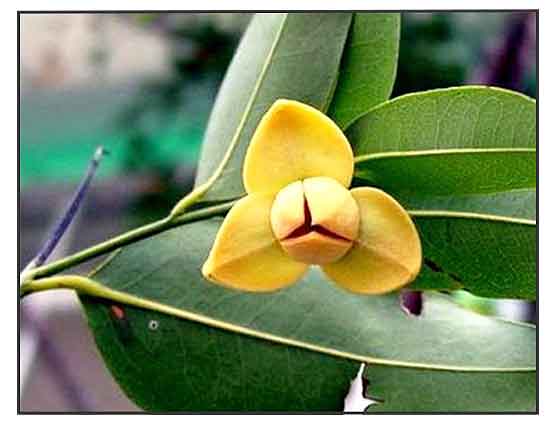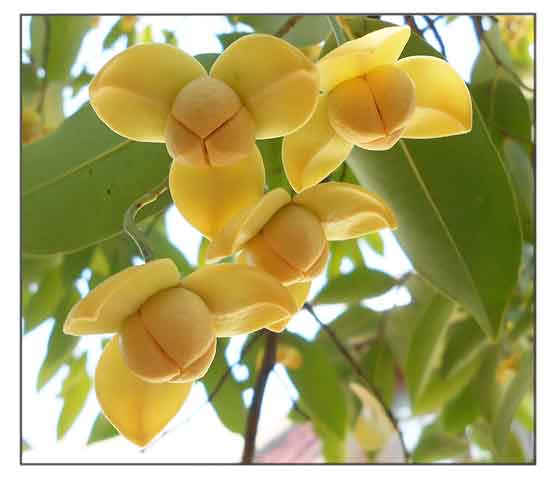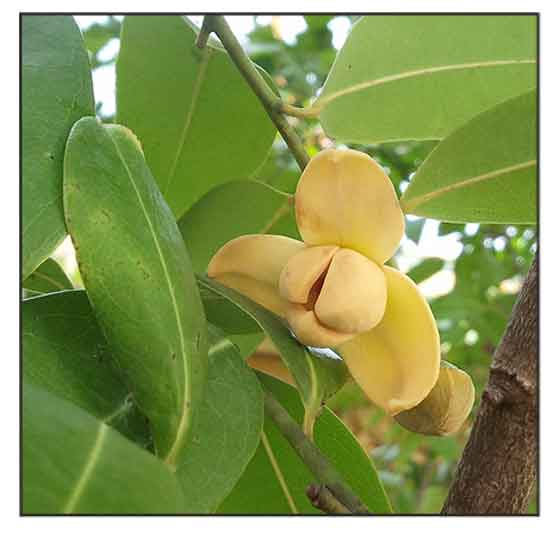 Gen info Gen info
- Sphaerocoryne affinis is a species of flowering plant in the soursop family, Annonaceae.
- In 2005, a royal decree by King Sihamoni of Cambodia proclaimed rumbuol the national flower of Cambodia. The flower was flagged as a symbol of environmental preservation by the government. (3)
- In Cambodia, several places are named for the plant: Romdoul District in Sray Vieng, and Ou Rumduol, a commune in Battambang province. (4)
Botany
• A tree that reaches a height of 8–12 m, with a stem diameter of up to 20–30 cm. Its simple leaves are arranged alternately on stems in two ranks. Leaves are lanceolate with a pronounced acumen. Petioles are 2.5-5 mm long, the sepals 2-3.5 mm long, the inner petals 5-8 mm long, and the floral receptacle about 1 mm high and 1.2-2.1 mm in diameter. It has yellowish-white flowers that give out an attractive smell in the late afternoon and evening, a distinctive fragrance that can be smelled from a long distance. (2) (8)
 • Tree or scandent shrub. Twigs drying brown, shallowly striate or latticed, glabrous but for a few pale hairs on the youngest parts. Leaves chartaceous, glaucous beneath, drying brown or grey-brown above, sometimes shiny, paler and duller beneath with midrib a contrasting red-brown, glabrous above, below with a scattering of pale adpressed hairs, sometimes almost glabrous, midrib flush above in dry leaves, prominent beneath, lateral nerves slightly raised on both surfaces, lamina elliptic, 4–14.5 × 1.5–5 cm, base acute, apex acuminate, lateral veins 14–18 pairs, tertiary venation clearly visible from both surfaces. Petioles 4–8 mm long, c. 1 mm thick. Inflorescences single-flowered, axillary. Flowers pedicel 15–16 mm long, c. 1 mm thick, widening distally, drying brown, striate, more or less glabrous, medial bract c. 1.5 × 1 mm, with sparse pale hairs, perianth sometimes 4-merous, sepals slightly connate at base, broadly ovate, c. 2 × 4 mm, drying black, sparse, short adpressed pale hairs outside, glabrous within, petals rather thick, outer petals broadly ovate, c. 7 × 6 mm, covered with short dense pale hairs, glabrous near base inside, inner petals c. 6 × 5 mm, hairy outside, more or less glabrous within, stamens many, carpels many, 1–1.5 mm long, white hairs near apex. Fruits pedicel 2–2.5 cm long, c. 1 mm thick, widening distally, calyx persistent, monocarps to 25 or more, ellipsoidal, typically drying 8–9 × 5–6 mm, 2-seeded fruits to 13 mm long, minutely beaked, drying dark red-brown, minutely pimpled, glabrous except for a few short pale hairs near the apex, stipe very slender, 8–14 mm long, c. 0.5 mm thick. Seeds 1, rarely 2, ellipsoidal, c. 8 × 6 mm, drying smooth, pale brown. (9) • Tree or scandent shrub. Twigs drying brown, shallowly striate or latticed, glabrous but for a few pale hairs on the youngest parts. Leaves chartaceous, glaucous beneath, drying brown or grey-brown above, sometimes shiny, paler and duller beneath with midrib a contrasting red-brown, glabrous above, below with a scattering of pale adpressed hairs, sometimes almost glabrous, midrib flush above in dry leaves, prominent beneath, lateral nerves slightly raised on both surfaces, lamina elliptic, 4–14.5 × 1.5–5 cm, base acute, apex acuminate, lateral veins 14–18 pairs, tertiary venation clearly visible from both surfaces. Petioles 4–8 mm long, c. 1 mm thick. Inflorescences single-flowered, axillary. Flowers pedicel 15–16 mm long, c. 1 mm thick, widening distally, drying brown, striate, more or less glabrous, medial bract c. 1.5 × 1 mm, with sparse pale hairs, perianth sometimes 4-merous, sepals slightly connate at base, broadly ovate, c. 2 × 4 mm, drying black, sparse, short adpressed pale hairs outside, glabrous within, petals rather thick, outer petals broadly ovate, c. 7 × 6 mm, covered with short dense pale hairs, glabrous near base inside, inner petals c. 6 × 5 mm, hairy outside, more or less glabrous within, stamens many, carpels many, 1–1.5 mm long, white hairs near apex. Fruits pedicel 2–2.5 cm long, c. 1 mm thick, widening distally, calyx persistent, monocarps to 25 or more, ellipsoidal, typically drying 8–9 × 5–6 mm, 2-seeded fruits to 13 mm long, minutely beaked, drying dark red-brown, minutely pimpled, glabrous except for a few short pale hairs near the apex, stipe very slender, 8–14 mm long, c. 0.5 mm thick. Seeds 1, rarely 2, ellipsoidal, c. 8 × 6 mm, drying smooth, pale brown. (9)
Distribution
- Native to the Philippines.
- In low and medium elevation forests.
- Also native to
Borneo, Jawa, Malaya, Thailand. (1)
Constituents
- A bioactive compound, acetylmelodorinol (AM), was isolated from the ethyl acetate fraction and evaluated its anticancer properties on HeLa. (see study below) (6)
Properties
- Fragrance: The yellowish-white flowers emit a potent and attractive smell from late afternoon, and more potently in the evening, carried for miles by night winds.
-
Studies have suggested antioxidant, anti-Parkinson , anticancer, antiproliferative, apoptotic properties.
Parts used
Flowers, fruit, bark, seeds.
 Uses Uses
Edibility
- Fruit is edible. emitting an alluring aroma that travels some distance.
Folkloric
- No reported folkloric medicinal use in the Philippines.
-
In Cambodia, flowers are used to treat dizziness and blood pressure; the bark used for treatment of fever.
- Bark used for treatment of animal and venomous snake bites.
Others
- Scent: In Cambodia, flower is used for scenting lip wax for ladies, called kramuon rumbuol. Oil from dried and ground powder of flowers used in aromatherapy.
- Wood: Stems used as firewood. Used for construction of house and boats. Also used for making bows and hunting tools. (4)
- Decorative: In Cambodia, blossoms were used to embellish women's hair and create hairstyle, and worn by young girls as necklaces.
- Cultural: Flowers are used in Buddhist blessing
Studies
• Antioxidant / Potential for Parkinson's Disease: There is a strong relationship between oxidative stress and PD. Antioxidant compounds have been considered as a novel therapy for PD. Study suggested rumdul fruit as a new potential candidate for PD treatment, and evaluated its activities on a fly model of Parkinson. Results showed rumdul fruit water extract (RFWE) has strong antioxidant capacity with DPPH IC50 of 85.62 µg/mL. At concentrations of of 3, 6, and 12 mg/mL, RFWE could ameliorate the locomotor disabilities and dopaminergic neuron degeneration. Although 12 and 18 mg/mL doses could induce some side effects on fly development and viability, the RFWE effectively rescued PD phenotypes on the fly model. The study contributed strong evidence for further research as a novel source for PD treatment. (3)
• Anticancer / Antiproliferative and Apoptotic / Fruit: The roots, bark, leaves, branches, and flowers of S. affinis have been reported to have anticancer activity. Study evaluated the anticancer potential of S. affinis fruit extracts using cervical cancer HeLa cells. The hexane fraction of fruit extract exhibited cytotoxicity against HeLa and Hek-293 (human embryonic kidney 293) with IC50s of 4.05-4.34 µg/mL and10.61-37.52 µg/mL, respectively. The extracts exhibited selective toxicity against cancer cells with selectivity index between 2.45-9.26. Cells treated with the hexane fraction showed increased level of histone H2A variant, γH2AX, a marker for DNA damage. HExpression of cyclin E, crucial for G1 and S phase transition, was reduced in cells treated with the extract. Treatment also decreased expression of PCNA mRNA, which is essential for replication. Results suggest anticancer effect by arresting the cell cycle of HeLa cells and inducing apoptosis via irreversible DNA damage. (4) (5)
• Acetylmelodorinal / Antiproliferative and Apoptotic on HeLa Cells / Seeds: Study evaluated seeds and pericarp of S. affinis fruit for cytotoxicity on LeLa cells. The solvent fraction from the seed exhibited considerably higher cytotoxicity against HeLa cells than those of the pericarp. A bioactive compound, acetylmelodorinol (AM), was isolated from the ethyl acetate fraction and evaluated its anticancer properties on HeLa. Treatment with AM inhibited HeLa cell proliferation with IC50 of 2.62 µg/mL. The AM disrupted cell cycle progression by reducing expression of cyclin E, CDK1/2, and AKT/mTOR pathways, increasing intracellular ROS levels, reducing BCL-2/BCL-XL expression, causing DNA fragmentation and nuclear shrinkage, and triggering apoptosis through caspase 3 and 9 activation in a dose- and time-dependent manner. Study establishes foundation for investigation of molecular mechanisms underlying AM's properties. (6)
• Effect of Ultrasonic Treatment on Antioxidant Level of Fruit Juice: Study evaluated the effects of ultrasonic power and time on the antioxidant content and activity of rumduol juice. In ultrasound-assisted extraction, the rumduol juice showed maximum antioxidant activity of 34.3 mM Trolox equivalent/100 g dry matter, estimated by ABTS assay, which was 59.7% higher than control without ultrasonic treatment. (7)
Availability
- Wild-crafted.
- Ornamental cultivation.
|

![]()






